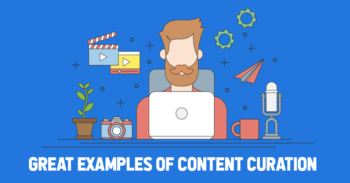The Ultimate Guide to SaaS Email Marketing

Email marketing for SaaS brands can be life or death when it comes to converting leads into customers, increasing your average customer’s LTV, and retaining clients longer. If you want to be able to scale your business, it’s not just about acquiring new leads but retaining and engaging the ones that the marketing team worked hard to get into your CRM.
SaaS audiences have unique needs, and knowing how to leverage SaaS email marketing can make a huge impact on your revenue and growth.
That’s what we’re going to discuss today.
In this Ultimate Guide to SaaS email marketing, we’re going talk about the components of a great marketing email, every type of email marketing campaign SaaS brands should have, and the must-follow best practices. All of it is chock-full of examples and is backed by data, so let’s get started.
4 Components of a Great SaaS Marketing Email
Before we start looking at the different types of SaaS email marketing campaigns we can create, let’s break down the anatomy of a great SaaS marketing email.
You need a subject line, a great visual if possible, persuasive body text, and a clear CTA.
Here’s an outstanding example of a SaaS email from Zapier. It’s an email that showcases a use-case of their automation software that’s immediately appealing to many workers: A week with no meetings.
We’ll use this as our example in the next section.

1. Strong Subject Line
First things first (quite literally in this case): You need a strong subject line.
Over 306 billion emails are sent and received on a daily basis, so you need to make sure that you’re standing out. The right subject line with help with that.
A subject line should:
- Tell the user what the email is about (and ideally provide motivation to click)
- Attention-grabbing
- Short: Best practices recommend keeping it to 9-60 characters
They can (but don’t have to) do the following:
- Use emoji
- Use either sentence case or title case (which determines what words are capitalized)
- Be creative
- Highlight the value of the email’s contents
Brevity will be key here; it’s a good practice to write at least three subject lines while you’re getting the hang of it and choosing the best one and to choose the one that accomplishes your goal in the fewest number of words possible.
So let’s look at our example. This email subject line from Zapier was “A week with no meetings” — simple, interesting, and brief but highly engaging. That’s a strong subject line, especially since the value proposition (no meetings) is front and center.

2. Great Visual
SaaS marketing emails don’t necessarily need to have visuals; we’ll actually look at several SaaS emails in this post that are highly effective without any images or GIFs.
That being said, they certainly don’t hurt, and having some visual elements (even if it’s just a branded header) can go a long way to making the email visually interesting. It can get your point across faster and capture a reader’s interest enough that they do, indeed, keep reading.
The visuals don’t have to be worthy of any Graphic Artist of the Year awards, but they do need to be interesting.
So, in our example, Zapier’s email is about a week with no meetings. Their visual was placed above the text, so users can see it the second they open the email, and it’s hard to deny how appealing it is: An empty schedule, totally free of meetings.
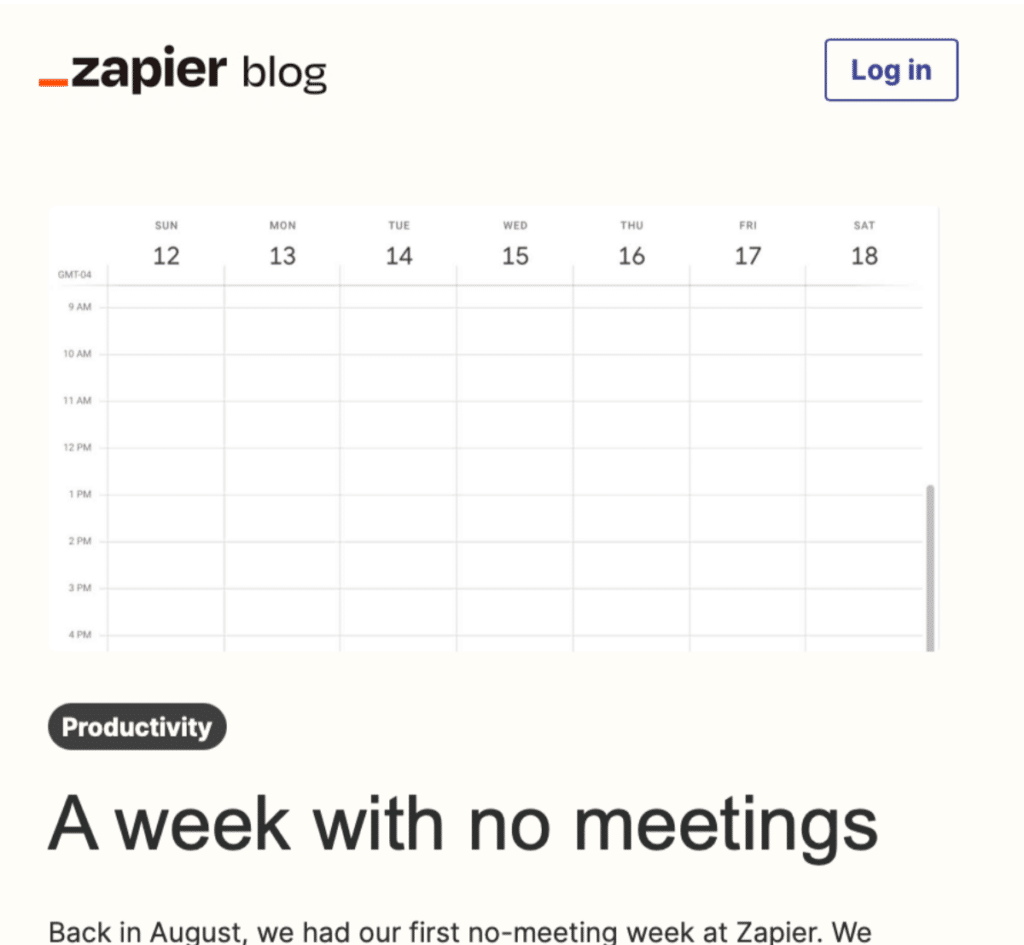
3. Persuasive or Informative Body Text
The body text needs to be excellent. It should either inform or persuade users (or, in many cases, both) about the specific message you want to convey.
Do you want to explain the benefits of upgrading and how it can help the user? Do you want to drive registrations to a content-heavy webinar?
Make sure that you’re answering the always-important question: Why should I care and what’s in it for me?
Zapier explains that the week with no meetings was done to “get stuff done,” and then details that they’ll walk you through the entire process, with tips to try it yourself. It’s interesting, it’s a no-pressure offer, but it’s engaging enough that you practically have to read the content.

(For anyone who is curious, by the way, you can see the post here).
With your body email, you want to:
- Ensure that it’s well-formatted with large-text headings or taglines, short paragraphs, and visuals to keep the email “scannable”
- Be as brief as possible and as thorough as possible; it’s a fine balance, especially since some emails only need 20 words and some need 200
- Explain what you have to offer, tell users how it benefits them, and then explain the action they need to take to get those benefits (even if it’s “click to read more”)
4. A Direct CTA
Last up, we’ve got a clear and very to-the-point call to action (CTA). Your CTA tells users what action you most want them to take, even if other secondary options are listed later (like “you can respond to this message directly for help” or links to your social profiles). It should, ideally, include a clickable CTA button.
The CTA button in our email example from Zapier is phenomenal, using contrasting colors and the great copy “Great stuff done.” When users click, it takes them right to the blog post in question.
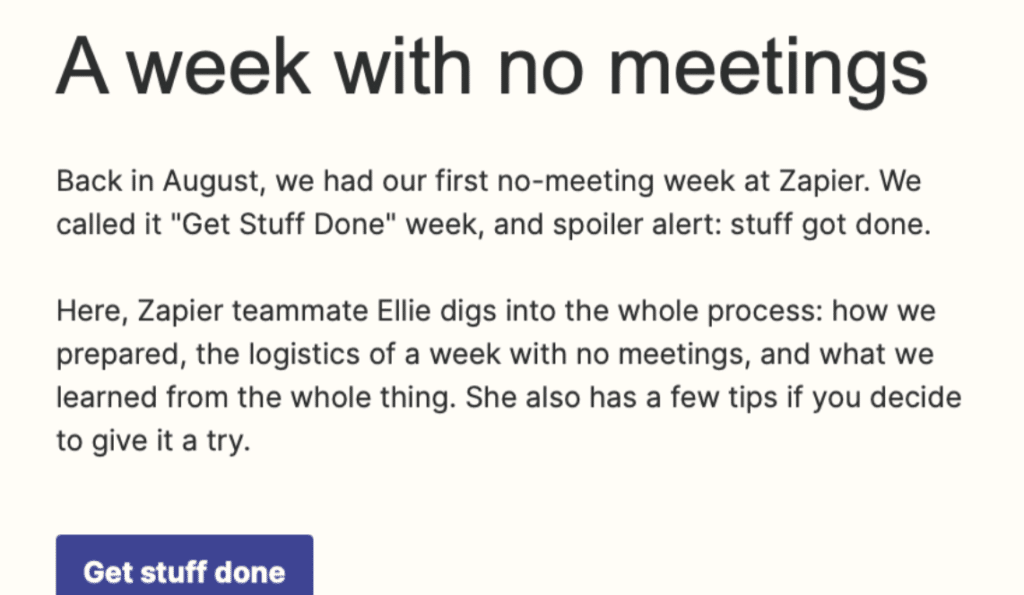
Every Type of SaaS Email Marketing Campaign to Create
When you’re getting started with SaaS email marketing, it can feel overwhelming. Email is often the primary point of contact for SaaS brands and their clients, and that means there’s an enormous number of campaigns to create.
To ensure you don’t miss anything, let’s go over the different types of email marketing campaigns you need as a SaaS brand.
Every Type of SaaS Email Marketing Campaign to Create
When you’re getting started with SaaS email marketing, it can feel overwhelming. Email is often the primary point of contact for SaaS brands and their clients, and that means there’s an enormous number of campaigns to create.
To ensure you don’t miss anything, let’s go over the different types of email marketing campaigns you need as a SaaS brand.
1. Welcome Email
First up we’ve got our welcome email series. This is a big one— it sets the tone for ongoing communication and it can start building a relationship. These campaigns should be set to go on an autoresponder basis so that users can get the messaging in their inbox right away.
Welcome emails may actually be broken down into a series of emails, but for the sake of this post, we’re going to look at welcome emails and onboarding emails separately. Welcome emails will include confirmation or verification emails, access to resources, and a reminder of what you’re getting by signing up.
There are different types of welcome email campaigns you’ll want to have ready to go:
- New email or newsletter sign-ups
- Free trial sign-ups
- New user/customer sign-ups (which can be sent both to account holders and individual users added to the plan)
Ideally, welcome emails will welcome you to the product and give you the resources you need to get started. The two images below are from a single welcome email from Leadpages, which does this incredibly effectively. It reminds users of how long their free trial lasts, what their plan is, and links to get started.
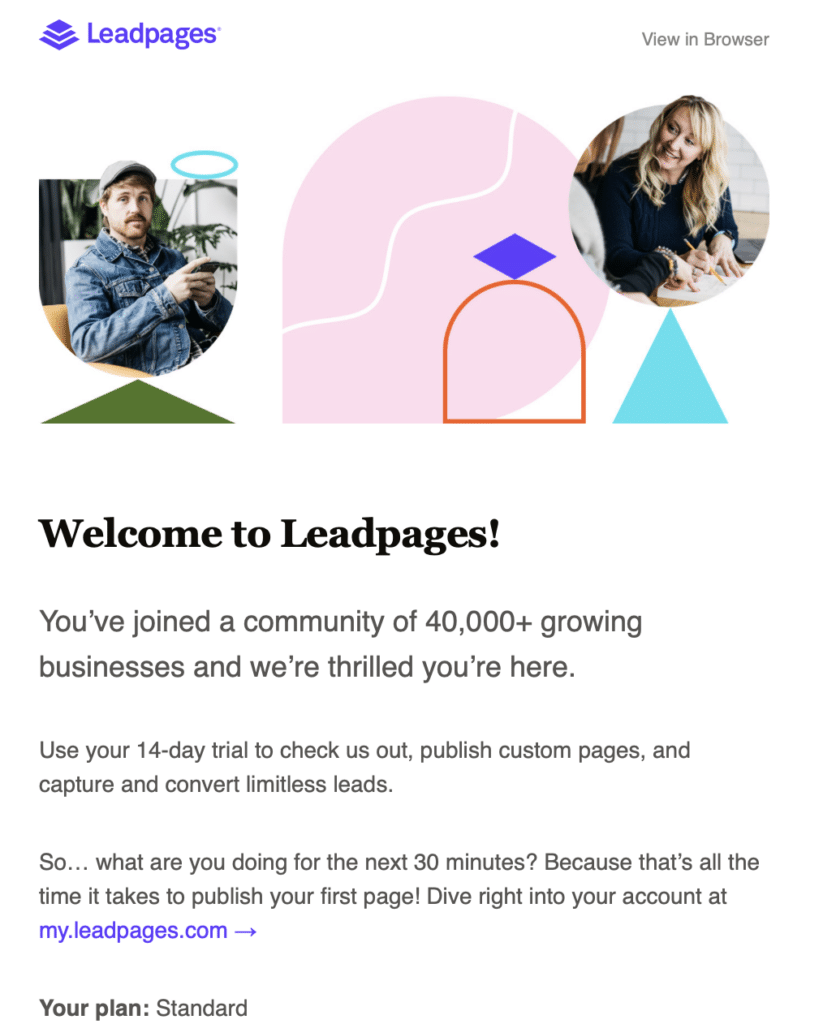
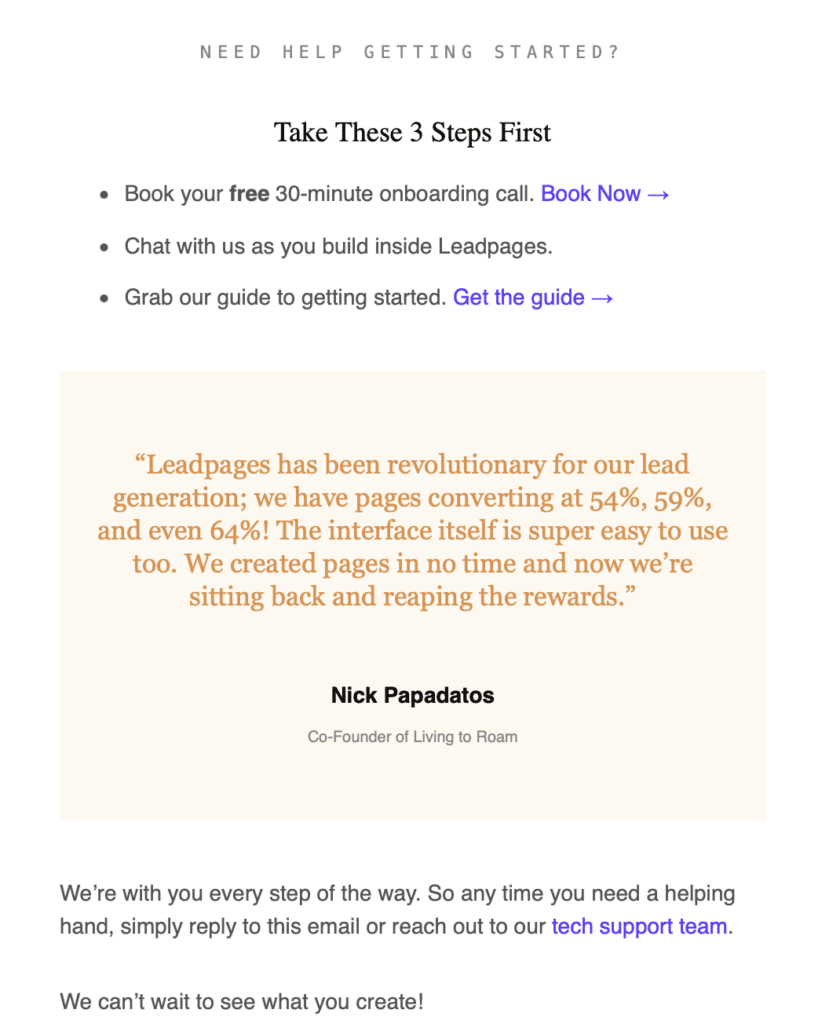
2. Onboarding Email Series
Some brands lump the two together, but I’m personally an advocate for having a welcome email series and a separate onboarding email series.
The onboarding email series is introducing users to your tool over the period of their free trial. It helps ensure they’re discovering how to use all the core features of your product and seeing value so that they’re ready to convert at the end of the free trial (or stay customers after the initial onboarding period).
Most onboarding email series:
- Are made up of between 2-10 emails over a several-week period
- Have individual emails that focus on a single aspect of your product and how to use it
- Explain why users should take certain actions
This is a great example from Breadcrumbs, which was titled “No data = no value.” It’s sent to users of the tool who haven’t yet connected a data source, which is vital to use the tool, and it overcomes objections while giving you the next steps to get started.
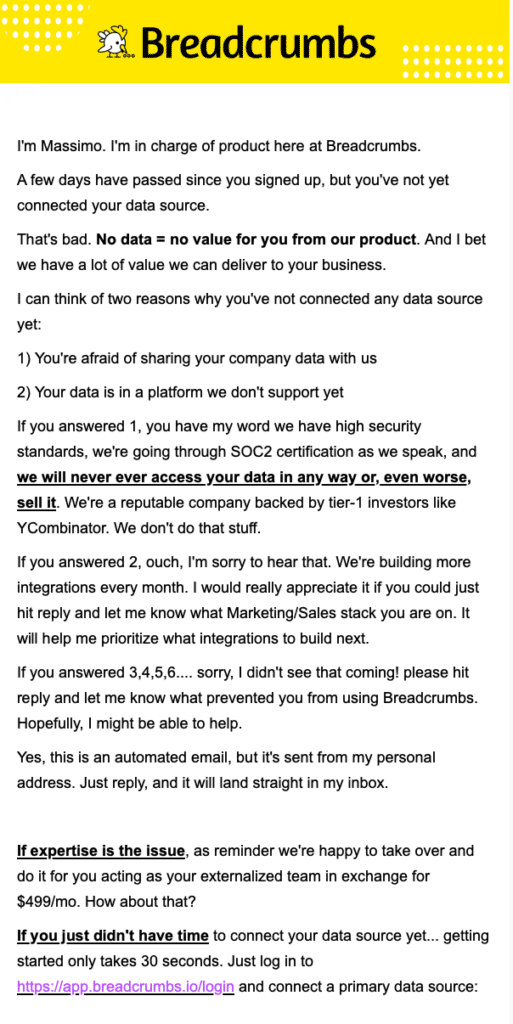
3. End-of-Trial Conversion Email
Users are approaching the end of their trial but haven’t converted. Reminding them of that end-of-trial date (whether it auto-renews with a paid subscription or not) is always a good idea.
At this point, reminding users a day before it renews is a great choice for a 7-day or 14-day trial; also sending a 7-day alert for a 30-day trial is a good call.
Make sure that you stress what users will lose access to if they fail to convert to a paid plan, and when it will happen. And always, always have a CTA button that takes them straight to the page where they need to go to convert.

4. Demo Scheduling Email Series
Do you offer demos for your tool? If so, you want to make sure that you have those autoresponders ready to go.
Demo scheduling email series often include:
- An email with a link to schedule a demo, if there wasn’t a link right on your site
- An email confirming the scheduled demo, with a link to reschedule if necessary
- An email reminding all participants of the demo an hour before it’s scheduled
- A follow-up email after the fact (though this may be personalized and sent directly from the account executive)
The biggest “must-do” when it comes to demo emails is to make it easy for users to get in touch with you and to book that demo (or reschedule it). Any friction at this point in the sales process could be enough to shut the process down altogether.
5. Follow-Up Email Series
At different points in the process, you’re going to have follow-up emails designed to drive users to the next stage of the sales funnel, whether that’s booking a demo, getting more use out of their trial, converting to paid customers, or upselling later on.
These emails can be automated, but it’s often a good idea to have some emails from sales representatives sprinkled in, too, especially during the early trial consideration stages.
At this point, you should always:
- Address the user by name in the email
- Say that you want to reach out and ask if they need any help
- Link to relevant resources that could benefit them based on current usage or stage of the sales funnel
- Have clear options for how they can get in touch

6. Product Education Series
Product education prioritizes teaching users how to get every ounce of greatness out of your SaaS tool, making it a vital type of SaaS email marketing campaign.
These emails can be sent at all points of the customer’s lifecycle, not just early on when they’re learning the tool. It can be used to demonstrate different use cases, explain how to get more out of the product, or share insights that the team has learned.
It’s often best to focus on a single use case or product feature with each individual email, and you’ll typically want to keep these to no more than once per week or once per month, depending on how often you’re emailing your user base.
This is where our earlier example from Zapier comes back into play. The email takes a content-style approach, but it ultimately highlights a great use case of some of Zapier’s features.
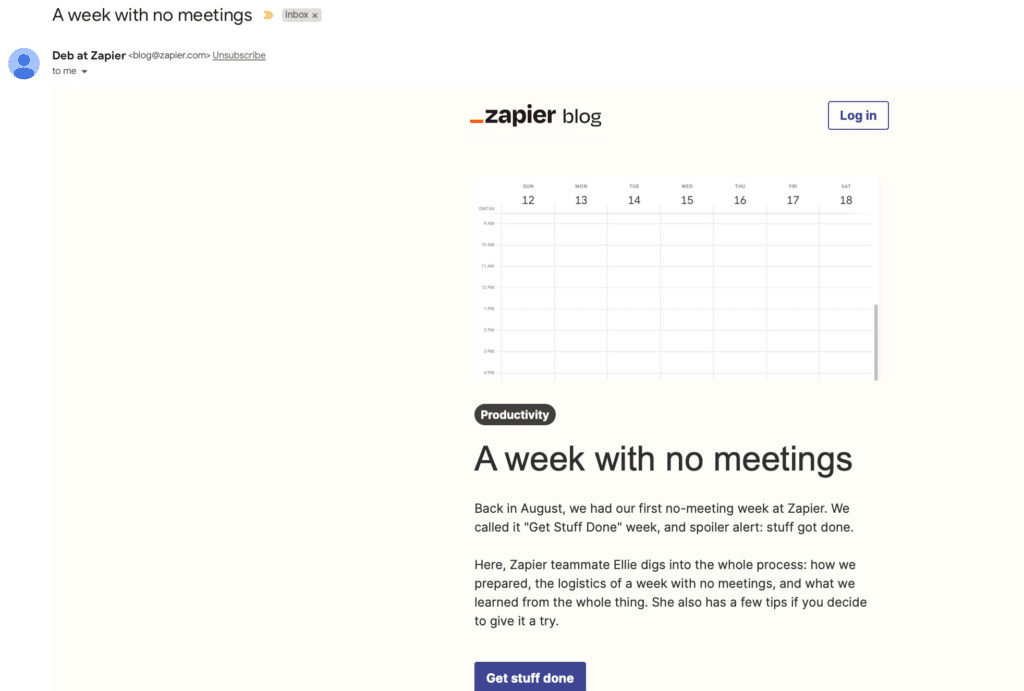
7. New Feature Series
Have a new feature? Email is the first way many of your users will discover it for the first time. A study by HubSpot found that B2B marketers said that new product and feature announcement marketing emails have the highest CTR out of all email campaigns.
Make sure you include a reference to the new feature in your email subject line, and then do the following:
- Explain what the new feature is
- Detail where to find it
- Share how to use it and how it can benefit the user
- Include a link to a video or blog post tutorial, if relevant
- Share an image of the new feature or interface, if relevant
Some brands will opt for monthly changelogs, which works well, too.
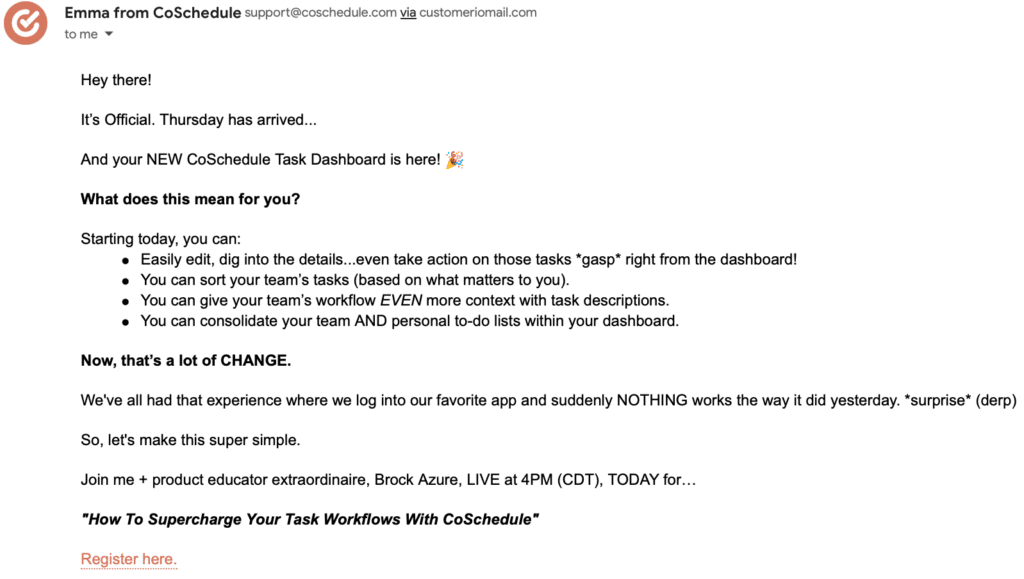
8. Re-engagement Campaigns
Re-engagement campaigns are designed to identify users who are at high risk of churn and re-engage them before that happens.
If users fail to log in for four days after they start their free trial, for example, there’s a decent chance they may not convert into paying customers. And if paying customers suddenly stop using the plan, that’s a sign they may churn entirely.
Re-engagement campaigns are most effective when they highlight the value that the product can offer, potentially showing use cases or specific features and giving users what they need to get started.
In some cases, re-engagement campaigns may be sent directly by a sales or customer support representative, but it never hurts to have autoresponders in place so no one slips between the cracks.

9. Upselling & Cross-Selling Campaigns
Upselling and cross-selling is vital for the revenue growth of many SaaS brands. I was upsold from a $10 a month invoicing software plan to an $89.99 a month plan, or example, significantly increasing my value as a single client to said service. With enough of those campaigns in place, you’re looking at massive growth.
Many of your existing customers, after all, are your biggest source of potential revenue growth. They may be interested in secondary products or services, or actually be a better fit for higher-cost plans without realizing it.
Cross-selling can be done with automation, promoting new features or services based on usecase. Upselling can also happen with autoresponder campaigns when users are hitting the max level of a plan or consistently engaging, but a personalized email from sales may be more effective here.
10. Billing Campaigns
This is a simple one, but it’s an important one.
There are billing issues every day, and in many cases, your users may not know that. If it wasn’t for the email below from Semrush after I had to cancel a credit card due to fraud, I wouldn’t have realized that my plan was about to expire.
Let users know that there’s an issue with their billing immediately; this should be an autoresponder campaign. And definitely let them know what they stand to lose (and by when) if they aren’t able to get it squared away.
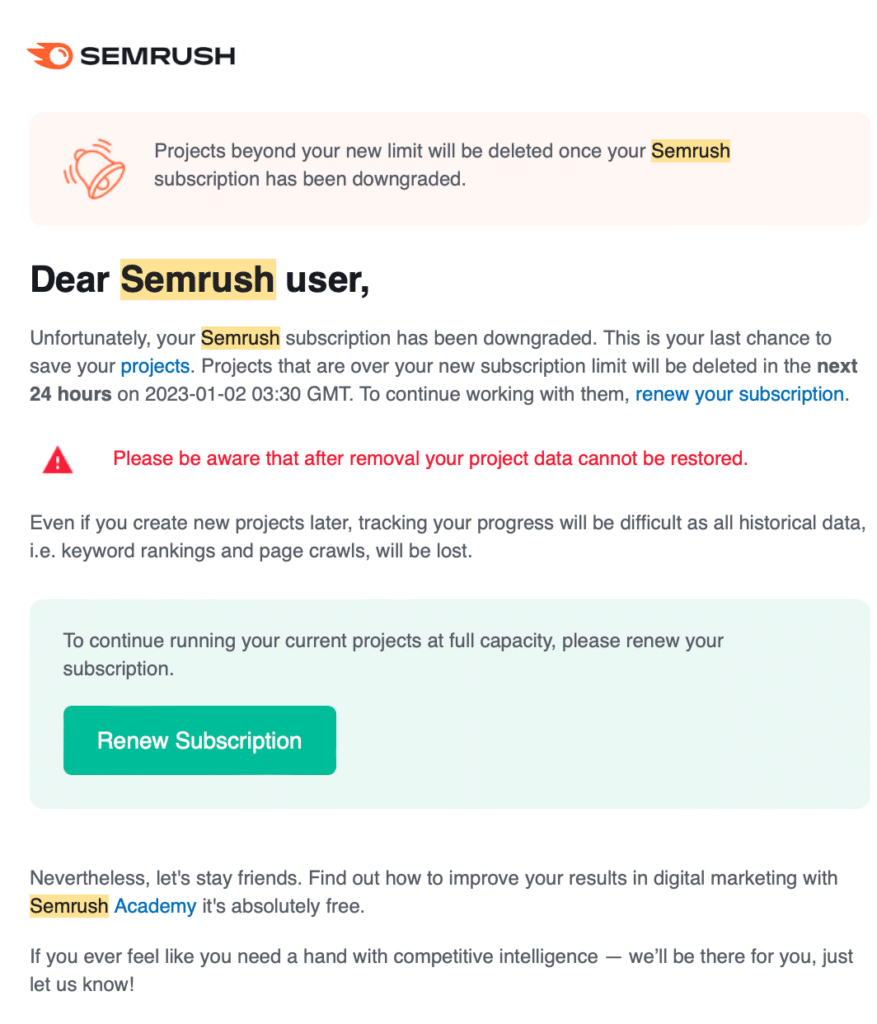
11. The Content-Focused Campaigns
Content marketing is a staple for most SaaS brands, and that can extend into your email marketing, too. These may be email newsletters, industry updates, or emails promoting content like webinars.
Having content-focused campaigns at least once per month is often a solid option; it allows you to continue building your relationships while offering value in a new way.
You do want to keep emails relatively brief (no more than a few paragraphs in most cases), but you can always link to external content.

9 SaaS Email Marketing Best Practices
Before we go, you know we’ve got to cover a few crucial best practices to help your campaigns reach their full potential! There are 9 essential SaaS email marketing best practices we highly recommend following.
1. Offer Value
Is it valuable for users to read at least some of your emails? If not, you’ll want to change that.
Users won’t keep opening your emails if they just feel like you want to sell to them. Offering insights, lessons, tips, and resources can keep them engaged and your email open rates high. Gusto, for example, sends updates about tax codes and schedules, helping their users stay informed.
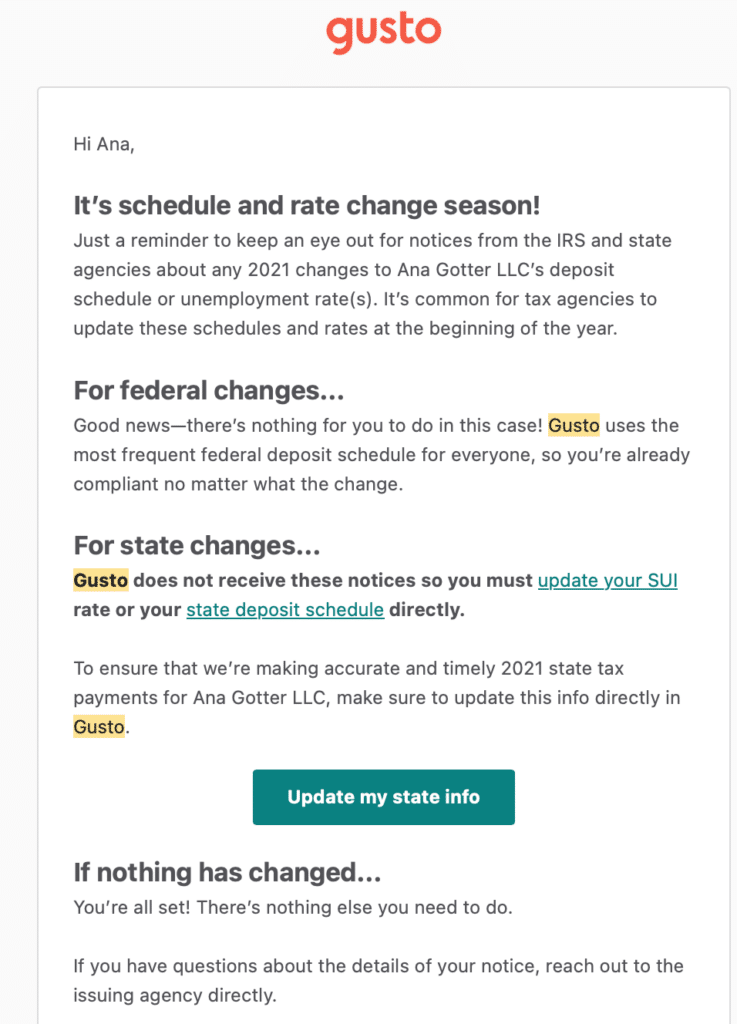
2. Create Segments Based on Primary Use Case
You’re likely going to have people who use your tool differently.
A content management system used by a freelancer to keep track of all the content they’re writing for clients will use that system very differently than an agency trying to create collaboration between sales and marketing.
It’s essential to understand how your audience is utilizing a tool and what audience segments they fall into. Once you do, you can segment your audiences accordingly and create relevant campaigns personalized to their needs and their primary use case.
3. Combine Autoresponders with Personalized Outreach
We’ve touched on this briefly, but it’s worth saying it again. Many successful SaaS brands will rely on a combination of autoresponder campaigns alongside personalized outreach.
Personalized outreach from a sales or customer support representative is the best way to learn about your customer’s needs. This is also where you may discover what objections they have, what needs aren’t being met, and how to overcome both obstacles.
Autoresponders are great, but you never want to rely on them exclusively, especially during the initial sales process.
4. Test Everything
You want to A/B test your emails, of course. Test the subject line, the images, the body copy, the CTAs, the formatting, all of it.
But you also want to QA and spam test your emails, too. One study found that 15.8% of all emails go missing or have been caught by popular spam filters. Another found that you’ll see up to a 28% higher return on your email campaigns when you implement QA, A/B, and spam testing for your emails.
Tools like Unbounce are great for split testing, and Litmus is a good option for other technical aspects of testing.
5. Choose Length Strategically
Some emails can be longer than others; content-style emails are going to naturally go longer than a product feature update in many cases.
It’s recommended that you stick to 50-125 characters for sales emails, and remember that customers spend an average of 10 seconds reading brand emails.
No matter what put the important and interesting stuff at the very top; anything below the fold has a decreased chance of being read by many readers.
6. Sender practices
A 2021 study by Pathwire found that when it comes to deciding to open an email, recognizing the sender is the single most influential factor.
Testing the name of the sender, therefore, is often a good call. And always including “Name from (Brand name)” is even more important— people need to know that it’s communication coming from your brand.
So you can have an email just from “Leadpages,” but “Laura from Leadpages” works exceptionally well; it’s way most SaaS brands have a real person’s name even if they’re using an autoresponder.
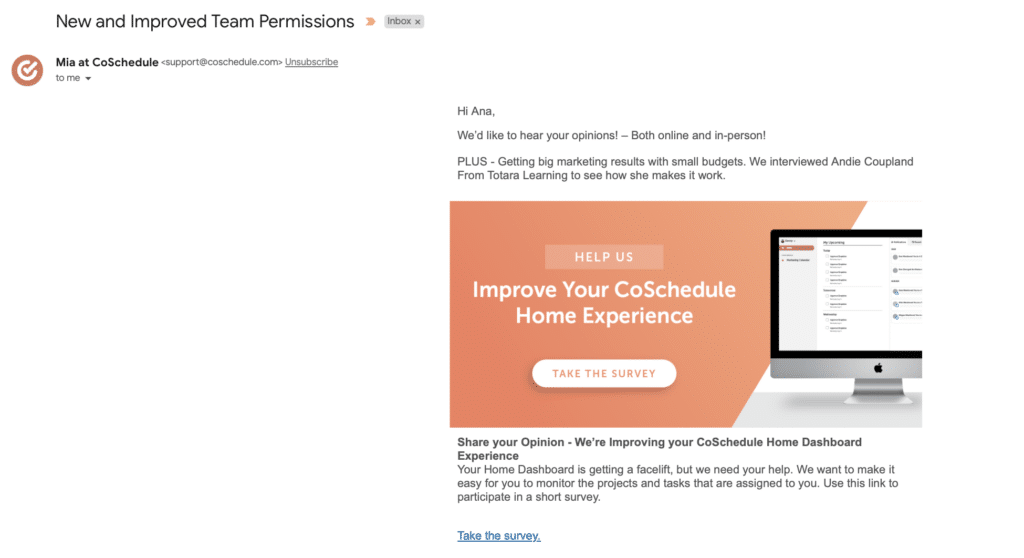
7. Mobile Friendly
You need to ensure that your emails are all fully mobile-responsive.
Keep this in mind:
- 41% of email views come from mobile devices
- 46% of smartphone users prefer brand communications through email
- Launching a mobile-responsive email design can increase unique mobile clicks by 15%
We know many of you are likely already using mobile-friendly templates or platforms (MailChimp, ActiveCampain, and the likes all fit this bill), but nearly 1 in 5 email campaigns aren’t optimized for mobile, so make sure you’re in the clear with this.
8. Get the Timing Right
You want to get the timing right when it comes to your email campaigns, and this is something that testing with your individual audience will help you discover.
How often should you send your emails, and what time of day or day of the week should you send them?
Autoresponders should naturally be locked and loaded for distribution based on triggered actions. But what about the rest?
Weekday communications are often most effective for SaaS brands, and emails sent throughout business Horus during the day are most likely to be opened.
You can also decrease the number of emails sent if subscribers seemed overwhelmed. 63% of businesses will actually reduce the frequency of emails sent based on the users’ levels of engagement.
9. Embrace Your Unique Brand
Email is going to be the most direct point of contact between you and your customers, so this is where your brand voice should shine strong and bright. That goes for branded imagery and colors, too.
We’ve seen quite a few examples of brands with strong voices that go outside of the “boring B2B” tone a lot of us know and not-quite-love. You’ve got two great examples here, both of which make you want to open more emails every time they show up in your inbox:


Final Thoughts
SaaS email marketing is a big task, so make sure that you have a killer copywriter and strategist on your team. You’ll want input from product teams, marketing teams, and sales teams; for this reason alone, it’s often best to keep the email marketing in-house instead of outsourcing to a third-party copywriter in my experience.
That being said, make sure that your copywriters understand and embrace your brand voice, and really grasp what makes your product great. With that information, solid strategy, and some creativity (and lots of testing!), get ready to watch your revenue increase.
Want to see more SaaS marketing examples? Check out our SaaS gallery here!
